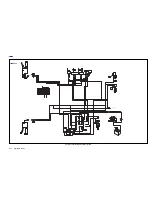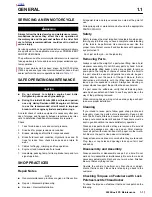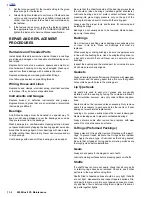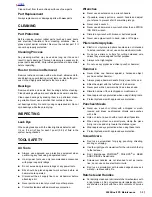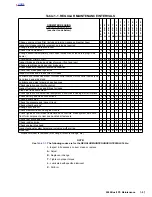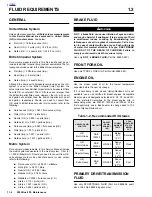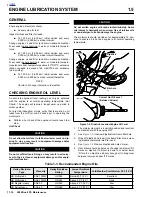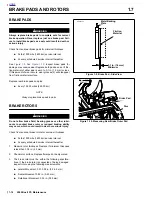
2002 Buell P3: Maintenance
1-3
HOME
Clean all rust from the machined surfaces of new parts.
Part Replacement
Always replace worn or damaged parts with
new
parts.
CLEANING
Part Protection
Before cleaning, protect rubber parts (such as hoses, boots
and electrical insulation) from cleaning solutions. Use a
grease-proof barrier material. Remove the rubber part if it
cannot be properly protected.
Cleaning Process
Any cleaning method may be used as long as it does not
result in parts damage. Thorough cleaning is necessary for
proper parts inspection. Strip rusted paint areas to bare metal
before repainting.
Rust or Corrosion Removal
Remove rust and corrosion with a wire brush, abrasive cloth,
sand blasting, vapor blasting or rust remover. Use buffing cro-
cus cloth on highly polished parts that are rusted.
Bearings
Remove shields and seals from bearings before cleaning.
Clean bearings with permanent shields and seals in solution.
Clean open bearings by soaking them in a petroleum clean-
ing solution. Never use a solution that contains chlorine.
Let bearings air dry. Do not dry using compressed air. Do not
spin bearings while they are drying.
INSPECTING
Leak Dye
When using leak dye with the black light leak detector, add
1/4 oz. (7.4 ml) of dye for each 1 quart (0.9 l) of fluid in the
system being checked.
TOOL SAFETY
Air Tools
●
Always use approved eye protection equipment when
performing any task using air-operated tools.
●
On all power tools, use only recommended accessories
with proper capacity ratings.
●
Do not exceed air pressure ratings of any power tools.
●
Bits should be placed against work surface before air
hammers are operated.
●
Disconnect the air supply line to an air hammer before
attaching a bit.
●
Never point an air tool at yourself or another person.
●
Protect bystanders with approved eye protection.
Wrenches
●
Never use an extension on a wrench handle.
●
If possible, always pull on a wrench handle and adjust
your stance to prevent a fall if something lets go.
●
Never cock a wrench.
●
Never use a hammer on any wrench other than a STRIK-
ING FACE wrench.
●
Discard any wrench with broken or battered points.
●
Never use a pipe wrench to bend, raise or lift a pipe.
Pliers/cutters/prybars
●
Plastic- or vinyl-covered pliers handles are not intended
to act as insulation; do not use on live electrical circuits.
●
Do not use pliers or cutters for cutting hardened wire
unless they were designed for that purpose.
●
Always cut at right angles.
●
Do not use any prybar as a chisel, punch or hammer.
Hammers
●
Never strike one hammer against a hardened object,
such as another hammer.
●
Always grasp a hammer handle firmly, close to the end.
●
Strike the object with the full face of the hammer.
●
Never work with a hammer which has a loose head.
●
Discard hammer if face is chipped or mushroomed.
●
Wear approved eye protection when using striking tools.
●
Protect bystanders with approved eye protection.
Punches/chisels
●
Never use a punch or chisel with a chipped or mush-
roomed end; dress mushroomed chisels and punches
with a file.
●
Hold a chisel or a punch with a tool holder if possible.
●
When using a chisel on a small piece, clamp the piece
firmly in a vise and chip toward the stationary jaw.
●
Wear approved eye protection when using these tools.
●
Protect bystanders with approved eye protection.
Screwdrivers
●
Don’t use a screwdriver for prying, punching, chiseling,
scoring or scraping.
●
Use the right type of screwdriver for the job; match the tip
to the fastener.
●
Don’t interchange POZIDRIV
®
, PHILLIPS
®
or REED
AND PRINCE screwdrivers.
●
Screwdriver handles are not intended to act as insula-
tion; do not use on live electrical circuits.
●
Don’t use a screwdriver with rounded edges because it
will slip – redress with a file.
Ratchets and Handles
●
Periodically clean and lubricate ratchet mechanisms with
a light grade oil. Do not replace parts individually; ratch-
ets should be rebuilt with the entire contents of service
kit.
Summary of Contents for 2002 P3
Page 2: ......
Page 17: ...A 15 Appendix A Tools HOME ...
Page 32: ...C 3 Appendix C Metric Conversions HOME ...
Page 41: ...1 8 2002 Buell P3 Maintenance HOME NOTES ...
Page 75: ......
Page 111: ...2 36 2002 Buell P3 Chassis HOME NOTES ...
Page 143: ...2 68 2002 Buell P3 Chassis HOME NOTES ...
Page 144: ...2002 Buell P3 Chassis 2 69 HOME ...
Page 146: ......
Page 147: ......
Page 223: ...3 76 2002 Buell P3 Engine HOME NOTES ...
Page 225: ......
Page 256: ...2002 Buell P3 Fuel System 4 31 HOME ...
Page 258: ......
Page 259: ......
Page 279: ...5 20 2002 Buell P3 Electric Starter HOME NOTES ...
Page 281: ......
Page 327: ......
Page 398: ...2002 Buell P3 Electrical 7 71 HOME ...
Page 400: ...Product 1 2 ...








